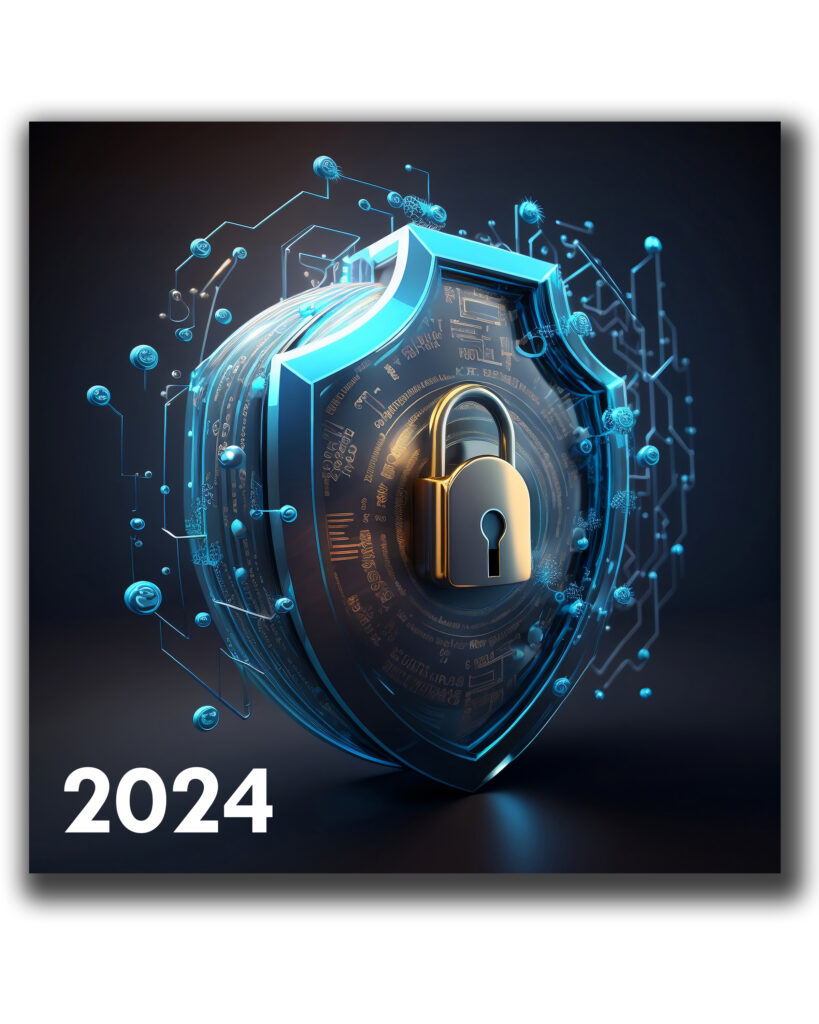As of my last update in January 2022, I can’t provide information on specific Cybersecurity innovations in 2024 . However, based on the trajectory of advancements and trends in the cybersecurity domain, here are potential areas where significant innovations might occur by 2024:
- AI-Powered Threat Detection and Response: Advancements in Artificial Intelligence (AI) and Machine Learning (ML) algorithms continue to revolutionize threat detection and response. By 2024, these technologies might become even more refined, enabling more accurate and proactive identification of cyber threats in real-time.
- Quantum-Safe Cryptography: With the potential rise of quantum computing, the need for quantum-resistant or quantum-safe cryptographic methods is anticipated to be a focal point by 2024. Innovations in this area aim to develop encryption methods that can withstand the threat posed by quantum computers to current encryption standards.
- Zero Trust Architecture: Zero Trust security principles, which assume zero trust for any entity, both inside and outside the network perimeter, are likely to become more prevalent. Innovations in this area might involve more sophisticated methods of continuous verification, strict access controls, and micro-segmentation to reduce the attack surface.
- Cybersecurity Automation and Orchestration: Automation and orchestration tools are expected to evolve further, allowing security teams to automate routine tasks, integrate various security solutions, and improve incident response times. By 2024, these innovations could streamline security operations and enhance overall resilience.
- Behavioral Analytics and User-Centric Security: Innovations in behavioral analytics might focus on monitoring user behaviors and establishing baseline patterns to detect anomalies or potential insider threats. User-centric security measures, such as adaptive authentication and personalized security protocols, may also see advancements to strengthen overall cybersecurity postures.
These areas represent ongoing trends and potential focal points for innovation in cybersecurity by 2024. However, the cybersecurity landscape is dynamic, and new technologies and approaches might emerge that could significantly impact the industry. For the most accurate and up-to-date information on cybersecurity innovations in 2024, I recommend consulting the latest industry reports, expert analyses, and technological developments at that time.
Cybersecurity Innovations: Cybersecurity innovations in 2024

Development of more robust cybersecurity measures to combat increasingly sophisticated cyber threats and protect sensitive data.
cybersecurity advancements keep on developing quickly, determined by the raising danger scene and the rising intricacy of digital assaults. A few basic progressions are reshaping the manner in which we approach computerized security.
One critical center lies in the improvement of proactive protection components. Customary network protection systems basically depended on responsive measures to battle dangers. Nonetheless, current advancements underscore proactive methodologies, for example, artificial intelligence and AI fueled frameworks. These frameworks can examine immense measures of information continuously to distinguish irregularities, recognize likely dangers, and answer quickly to relieve chances. This prescient ability empowers associations to expect and forestall assaults before they can cause significant harm.
Besides, the coordination of Zero Trust design is acquiring conspicuousness. This model works under the presumption that no element — whether inside or outside the organization — ought to be relied upon naturally. It stresses consistent check and severe access controls, guaranteeing that each entrance demand is validated and approved, in this manner limiting the assault surface and restricting the effect of likely breaks.
Furthermore, progressions in encryption advances assume a crucial part in defending touchy information. Quantum-safe encryption strategies are being created to endure the potential danger presented by quantum PCs, which might actually break current encryption norms. These new encryption methods plan to guarantee information stays secure and private, even notwithstanding quantum figuring capacities.
Moreover, the rise of Safety Organization, Robotization, and Reaction (Take off) stages smoothes out and computerizes occurrence reaction work processes. These frameworks incorporate different security instruments and innovations to give a concentrated perspective on security episodes, empowering fast recognition, examination, and remediation of dangers. Computerization inside these stages reduces the weight in security groups, permitting them to zero in on additional perplexing undertakings.
In the midst of these developments, there is a developing accentuation on network safety mindfulness and training. Human blunder stays a critical weakness, and teaching clients about prescribed procedures, phishing assaults, and social designing strategies is urgent in strengthening the general security stance of associations

Advancements in cybersecurity : Cybersecurity innovations in 2024
Certainly, the advancements in cybersecurity bring several advantages that significantly enhance digital defense strategies and protection against evolving threats:
- Proactive Threat Detection: Innovative technologies like AI and machine learning enable the detection of anomalies and potential threats in real-time. This proactive approach allows for the identification of suspicious activities before they can cause significant damage.
- Improved Incident Response: Security Orchestration, Automation, and Response (SOAR) platforms streamline incident response workflows. Automation helps in rapidly identifying and responding to security incidents, reducing response times and minimizing the impact of potential breaches.
- Enhanced Data Protection: Advanced encryption methods, including quantum-resistant encryption, bolster data security. These encryption techniques ensure that sensitive information remains protected, even in the face of emerging technological threats like quantum computing.
- Reduced Attack Surface: The implementation of Zero Trust architecture reduces the attack surface by enforcing strict access controls. This model assumes zero trust, requiring continuous verification of user identity and access privileges, thereby limiting potential entry points for attackers.
- Efficient Resource Utilization: Automation and AI-driven systems in cybersecurity operations optimize resource utilization. These technologies reduce the burden on cybersecurity professionals by automating routine tasks, allowing them to focus on more complex threats and strategic initiatives.
- Increased Security Awareness: Emphasis on cybersecurity education and awareness helps in building a more security-conscious culture within organizations. Educated users are more vigilant against threats like phishing attacks and social engineering, reducing the likelihood of successful cyber attacks.
- Adaptability to Emerging Threats: Continuous innovation in cybersecurity technologies ensures adaptability to emerging threats. This flexibility allows security measures to evolve alongside new attack vectors and rapidly changing cybersecurity landscapes.
- Compliance and Regulatory Alignment: Advanced cybersecurity measures often aid in meeting compliance requirements and aligning with regulatory standards. This is crucial for industries dealing with sensitive data and ensures adherence to legal frameworks.
- Business Continuity and Trust: Robust cybersecurity measures contribute to business continuity by safeguarding critical systems and data. Additionally, they help maintain customer trust and confidence by demonstrating a commitment to protecting sensitive information.
- Cost Savings in the Long Run: While initial investment in advanced cybersecurity technologies might seem substantial, these measures can potentially save significant costs associated with data breaches, legal liabilities, and reputation damage caused by successful cyber attacks.
Overall, these advancements in cybersecurity technologies offer multifaceted advantages by fortifying defenses, enabling rapid response to threats, and fostering a more secure digital environment for individuals and organizations alike.
Economics of Human Capital: Nurturing the Workforce of Tomorrow
Economics matters assumes a crucial part in forming the future by impacting different parts of society, strategy making, and individual navigation. The following are multiple manners by which Economics matters can add to forming what’s in store:
Strategy Detailing: Financial aspects gives the system to policymakers to go with informed choices. It assists in understanding what approaches with meaning for various areas, people, and the general economy. By breaking down financial information and patterns, policymakers can configuration better approaches for practical development, social government assistance, and steadiness.
innovation and Advancement: Financial matters impacts the assignment of assets towards exploration, improvement, and development. Understanding the financial ramifications of mechanical headways helps in cultivating development amicable conditions and molding the bearing of innovative advancement.
Globalization and Exchange: Financial aspects helps in grasping the elements of worldwide exchange and globalization. It guides nations in framing economic alliance, forming international strategy, and deciding the effect of worldwide monetary joining on various areas and social orders.
Natural Maintainability: Ecological financial aspects centers around the connection between monetary action and the climate. It helps in assessing the expenses and advantages of natural strategies, advancing reasonable practices, and resolving issues like environmental change and asset exhaustion.
Imbalance and Social Government assistance: Financial aspects gives experiences into pay circulation, destitution, and social government assistance. It assists in planning arrangements with decreasing disparity, reduce neediness, and further develop admittance to schooling, medical services, and fundamental requirements for all people.
Work Markets and Fate of Work: Financial matters assists in figuring out work with showcasing patterns, mechanical disturbances, and changing labor force elements. This information is significant in planning for the eventual fate of work, guaranteeing employability, and tending to difficulties presented via computerization and man-made consciousness.
Medical care and Public Administrations: Financial examination supports planning productive medical care frameworks and public help conveyance instruments. It helps in advancing asset allotment, further developing admittance to quality medical care, and improving the viability of public administrations.
Monetary Steadiness and Guideline: Financial aspects assumes a pivotal part in figuring out monetary business sectors, overseeing chances, and guaranteeing monetary security. It guides policymakers in figuring out guidelines to forestall monetary emergencies and keep a stable financial climate.
Social Economics and Direction: Understanding human way of behaving and dynamic from the perspective of financial aspects assists in planning arrangements that with empowering beneficial ways of behaving, like reserve funds, sound living, and supportable utilization.
Prescient Demonstrating and Guaging: Financial models and examination add to anticipating future patterns and possible results. This anticipating ability helps people, organizations, and states in going with additional educated choices for what’s to come.
.